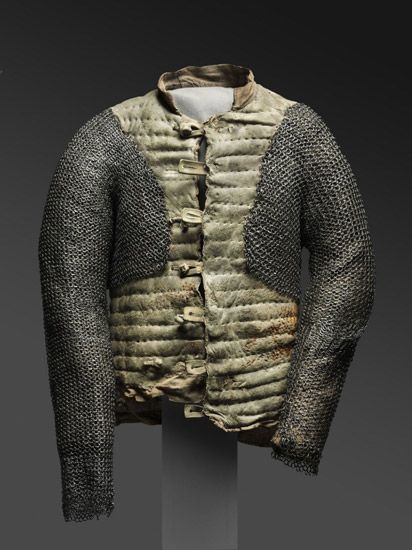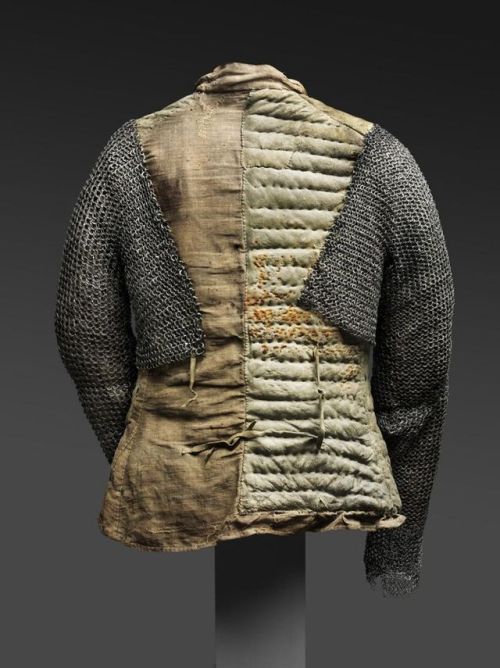elsegno: petermorwood: victoriansword:elsegno:alchemicalseraph:elsegno:hunlarpfag:elsegno:
elsegno: petermorwood: victoriansword: elsegno: alchemicalseraph: elsegno: hunlarpfag: elsegno: Arming jacket or doublet, 16th century. Note the maille sleeves and maille integrated into the body of the piece. There are a number of doublets that outwardly appeared to be unarmored, but in fact had maille sleeves and an up-armored torso (both maille and scales of plate), and were fairly prevalent in the 16th and 17th centuries. Vincento Saviolo has an anecdote where two individuals went out of a city to fight a duel, and one man asked the other to open his (armored) doublet and assure him that he was not carrying a concealed pistol. The asker prompty stabbed him. The stabee survived and tracked the fellow down again to return the favor, but everyday wear often included various components of light armor. [ @we-are-rogue , relevant to your present discussion of light armor? ] on the note of later stuff there was a thing called jack of plates, and looks kind of similar to other textile armours. But actually between the layers of textile there were little square shaped metal plates sewn inside and overlapping. It could actually protect from pistol bullets as you can see it on the picture. The bullet did not penetrated the inner layerHere are a few more pic about that thing and aslo X-ray pics too. Yeeaaa buddy. Love this stuff for the lattice that was used to distribute force. Really popular England too, especially the Border Reivers. I’d like to make something like in the first post. I’ve made maille before, so I can get that worked out. Anyone out there have any good patterns or ideas/experience sewing the linen part? I’m figuring something along the lines of linen interior with sail weight canvas exterior and 2 to 3 inch cotton batting I’m between. It should sew down to about an eight to a quarter inch thick and become fairly dense…. just not sure about patterns for the jacket or how to attach the maille sleeves and voiders… @fulminata2 you’ve made one of these before, correct? At least the cloth substrate? Here is an English doublet of defense circa 1580, from the 1996 Peter Finer catalog. As far as I’m aware the catalog is the only place this piece was published. It is a padded doublet rather than plated. The brigandine was an earlier version of the jack-of-plates, and in many instances made a style statement of the rivets holding the “concealed” plates - everyone knew they were there - in place between the layers. The rivets were polished, gilded, arranged in patterns, sometimes even star-shaped; it was all to Look Good. This is ancient and faded; when new the fabric would have been crimson velvet (completely covering the plates) and the rivets would have been tinned silver-bright against the dark red. Note: the OP arming-doublet is the plate-armour equivalent of the padded gambeson / aketon worn under mail; instead of being two separate layers, the arming-doublet was a padded garment with attached sections of mail to cover vulnerable places between the plates, usually on the arms - elbow joints and armpits in particular. This is Archduke Sigismund of Tyrol’s Gothic plate: it doesn’t have an arming-doublet in place, but the red under-garment shows where mail would be required.Arming-doublets are an integral part of a more complete armour, and shouldn’t be thought of as a stand-alone “garment” of the same style as the Doublet of Defence or even the Jack of Plates, both of which could be dressed up (or made “privy and secret”) with a top layer of more dressy fabric. The top layer of an arming doublet was plate steel. The top layer on the breast portion of that style of arming doublet wasn’t always full plate though! For shock cavalry, they often favored the more mobile maille sleeves of the arming doublet with a breastplate and gorget on the top of the merely padded segment. My favorite portrait of Phillip II includes just that arrangement. Note that his breastplate has a lance rest and that he wears spurs, in agreement with the image of a cavalry trooper: -- source link
Tumblr Blog : www.tumblr.com

